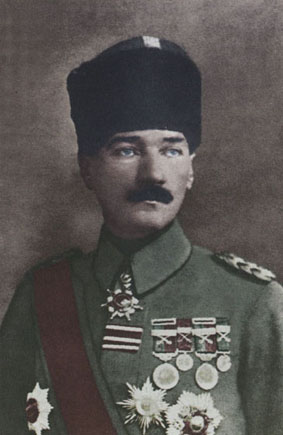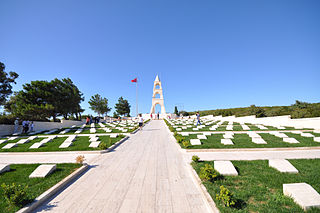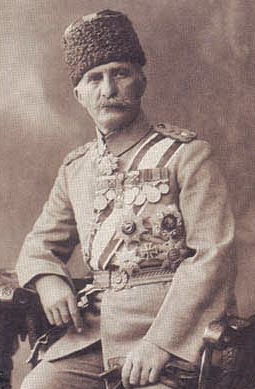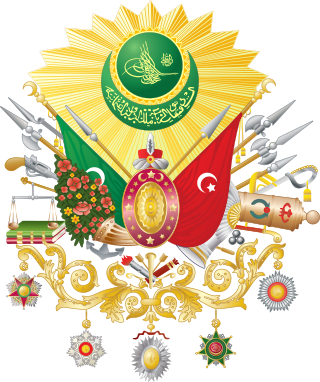Related Research Articles

The Gallipoli campaign was a military campaign in the First World War that took place on the Gallipoli peninsula, from 17 February 1915 to 9 January 1916. The Entente powers, Britain, France and Russia, sought to weaken the Ottoman Empire, one of the Central Powers, by taking control of the Ottoman straits. This would expose the Ottoman capital at Constantinople to bombardment by Allied battleships and cut it off from the Asian part of the empire. With Turkey defeated, the Suez Canal would be safe and a year-round Allied supply route could be opened through the Black Sea to warm-water ports in Russia.

The Battle of Chunuk Bair was a World War I battle fought between the Ottoman defenders and troops of the British Empire over control of the peak in August 1915. The capture of Chunuk Bair,, the secondary peak of the Sari Bair range, was one of the two objectives of the Battle of Sari Bair.

The Fifth Army of the Ottoman Empire or Turkish Fifth Army was formed on March 24, 1915, and dissolved on November 21, 1918. It was assigned the responsibility of defending the Dardanelles straits in World War I. The original commander of the army was the German military advisor to the Ottoman Empire, General Otto Liman von Sanders. The command passed to Vehip Pasha who became responsible for the Helles front while von Sanders still wielded considerable influence.

The landing at Anzac Cove on Sunday, 25 April 1915, also known as the landing at Gaba Tepe and, to the Turks, as the Arıburnu Battle, was part of the amphibious invasion of the Gallipoli Peninsula by the forces of the British Empire, which began the land phase of the Gallipoli Campaign of the First World War.

The Battle of Megiddo, also known in Turkish as the Nablus Hezimeti or the Nablus Yarması, was fought between 19 and 25 September 1918, on the Plain of Sharon, in front of Tulkarm, Tabsor and Arara in the Judean Hills as well as on the Esdralon Plain at Nazareth, Afulah, Beisan, Jenin and Samakh. Its name, which has been described as "perhaps misleading" since very limited fighting took place near Tel Megiddo, was chosen by Allenby for its biblical and symbolic resonance.

The Middle Eastern theatre of World War I saw action between 29 October 1914 and 30 October 1918. The combatants were, on one side, the Ottoman Empire, with some assistance from the other Central Powers; and on the other side, the British as well as troops from the British Dominions of Australia, Canada and New Zealand, the Russians and the French from among the Allied Powers. There were five main campaigns: the Sinai and Palestine Campaign, the Mesopotamian Campaign, the Caucasus Campaign, the Persian Campaign, and the Gallipoli Campaign. There were also several minor campaigns: Arab Campaign, and South Arabia Campaign.
The Second Army of the Ottoman Empire was one of the field armies of the Ottoman Army. It was formed in the late 19th century during Ottoman military reforms.

Mustafa Kemal Atatürk was a field marshal, revolutionary statesman, and founder of the Republic of Turkey as well as its first president. Mustafa Kemal Atatürk's military career explains his life between graduation from Ottoman War College in Istanbul as a lieutenant in 1905 to his resignation from the Ottoman Army on 8 July 1919, as well as his military leadership throughout the subsequent Turkish War of Independence.

The 57th Infantry Regiment Memorial is a Turkish war memorial commemorating the men of the Ottoman 57th Infantry Regiment who died during the Gallipoli campaign.

The Ottoman Seventh Army was a large military formation of the Ottoman Empire in the late 19th and early 20th centuries. Although designated as an army, at least by 1918, it was only of corps strength.

The 57th Infantry Regiment or simply 57th Regiment was a regiment of the Ottoman Army during World War I. In response to the landing at Anzac Cove of Australian and New Zealand forces on 25 April 1915 the 57th Regiment counterattacked, slowed the Allied advance and lost about half of its personnel. Mustafa Kemal later noted that the 57th Regiment was "a famous regiment this, because it was completely wiped out".

Hüseyin Avni Bey was the commander of the 57th Infantry Regiment of the Ottoman Army at the Battle of Gallipoli during which he led a counterattack that successfully stabilized the right flank of the Turkish defences on the 25 April 1915.
The First Army or First Guards Army of the Ottoman Empire was one of the field armies of the Ottoman Army. It was formed in the middle 19th century during Ottoman military reforms.

The III Corps of the Ottoman Empire was one of the corps of the Ottoman Army. It was formed in the early 20th century during Ottoman military reforms.
The Eighth Army of the Ottoman Empire was one of the field armies of the Ottoman Army. It was established during World War I.

The Yildirim Army Group or Thunderbolt Army Group of the Ottoman Empire or Army Group F was an Army Group of the Ottoman Army during World War I. While being an Ottoman unit, it also contained the German Asia Corps.

Esat Pasha Janina, known as Mehmed Esad Bülkat after the 1934 Surname Law, was an Ottoman general during the First Balkan War, where he led the Yanya Corps, and in World War I, where he was the senior Ottoman commander in the Gallipoli campaign.

Mehmed Şefik known as Mehmet Şefik Aker after the 1934 Surname Law, was an officer of the Ottoman Army and the Turkish Army. He is best known for his service during the Gallipoli campaign and in particular the defense he led during the first day of the Allied landing on 25 April 1915. He subsequently served in a number of senior roles during the rest of World War I and during the War of Independence.
The 19th Infantry Division was a formation of the Ottoman Army, during the Balkan Wars and the First World War. Two thirds of the division was made up of Syrian Arabs, who faced the first wave of the Allied invasion during the Gallipoli campaign, and one third were Turks.

The Ottoman Army was the army of the Ottoman Empire after the country was reorganized along modern western European lines during the Tanzimat modernization period. It operated during the decline and dissolution of the empire, which roughly occurred between 1861 and 1918, the end of World War I for the Ottomans. The Crimean War was the first war effort in which the modern army took part, proving itself as a decent force. The last reorganization occurred during the Second Constitutional Era.
References
- Footnotes
- ↑ McKay 2018, p. 93.
- ↑ Tamari & Turjman 2011, p. 13.
- ↑ Erickson 2001, pp. 76–77.
- ↑ "The forgotten Arabs of Gallipoli". www.aljazeera.com. Retrieved 2020-05-09.
- Sources
- Bean, Charles (1941) [1921]. The Story of Anzac from 4 May 1915, to the Evacuation of the Gallipoli Peninsula. Official History of Australia in the War of 1914–1918. Vol. II (11th ed.). Canberra: Australian War Memorial. OCLC 39157087.
- Erickson, Edward J. (2001) [2000]. Ordered to Die: A History of the Ottoman Army in the First World War. Westport, Connecticut: Greenwood. ISBN 978-0-313-31516-9.
- McKay, Jim (2018-05-24). Transnational Tourism Experiences at Gallipoli. Springer. ISBN 978-981-13-0026-4.
- Tamari, Salim; Turjman, Ihsan Salih (2011-05-07). Year of the Locust: A Soldier's Diary and the Erasure of Palestine's Ottoman Past. University of California Press. ISBN 978-0-520-25955-3.